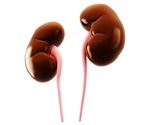Moving stones with sound—new ultrasound technology repositions kidney stones in people
Dr.Dram,profdrram@gmail.com,Hiv,Hepatitis and sex diseases expert +917838059592,+919434143550
 Researchers have developed new ultrasonic propulsion technology that can reposition kidney stones and facilitate stone fragment passage in people. Kidney stones are one of the most common disorders of the urinary tract. Smaller stones may pass with little or no pain, while larger stones may get stuck along the lower urinary tract and block the flow of urine, causing severe pain and/or bleeding. Current treatments for kidney stones, such as lithotripsy, may leave behind residual stone fragments. Most fragments will pass on their own, but others may grow larger, cause pain, and lead to the need for additional treatment.
Researchers have developed new ultrasonic propulsion technology that can reposition kidney stones and facilitate stone fragment passage in people. Kidney stones are one of the most common disorders of the urinary tract. Smaller stones may pass with little or no pain, while larger stones may get stuck along the lower urinary tract and block the flow of urine, causing severe pain and/or bleeding. Current treatments for kidney stones, such as lithotripsy, may leave behind residual stone fragments. Most fragments will pass on their own, but others may grow larger, cause pain, and lead to the need for additional treatment.
Toward the goals of finding safe ways to reposition kidney stones and encouraging the passage of stone fragments, scientists developed ultrasonic propulsion technology. The technology uses a handheld device to generate a real-time ultrasound image to visualize the kidney stone, and directs controlled, short bursts of ultrasound waves toward the stone to try to make it move.
In the first human clinical trial testing this technology, scientists found that it could reposition kidney stones in 14 of 15 men and women studied, and cause some degree of movement of both large and small stones. In fact, one person experienced pain relief after a large, obstructing stone was moved. These findings suggest that the procedure could successfully reposition kidney stones in some people.
The scientists then examined six study participants who had residual stone fragments after previously undergoing a lithotripsy procedure to treat their kidney stones. Four of them passed more than 30 fragments within days after undergoing the ultrasonic propulsion procedure, demonstrating that the technology could facilitate the passage of stone fragments. An unexpected finding was that the technology may also be useful for diagnosis—in four people, what was thought to be one large stone was actually found to be a cluster of small, passable stones after they were moved. Stone size is an important factor that doctors consider when making treatment decisions, so having this diagnostic information could aid them in making those decisions. Importantly, the technology was found to be safe and did not cause pain.
It is also noninvasive and could be performed in a clinic setting while people are awake without the need for sedation. Ultrasound propulsion technology is still being refined and tested in people, but with further research, it may eventually be possible to use this new technology after procedures that leave residual stone fragments to facilitate their passage and potentially reduce the need for future intervention. The technology may also be useful for moving large, obstructing stones; repositioning stones before surgery; and serving as a diagnostic tool.
- Kidney stones universally present hazard in north india,dillution by water prevent it
- Steroid and placebo effect equally for mild persisting asthma with low sputum eosinophils
- Government wants to fix public healthcare staff shortages with ayush docs: will it work?
- Plea in hc for payment of salaries of edmc, north mcd teachers and doctors
- 7 indian pharma companies named in us lawsuit over inflating generic drug prices
- Woman in up dies after explosion in her mouth during treatment,what is diagnosis?
- Woman in up dies after explosion in her mouth during treatment,what is diagnosis?
- Woman in up dies after explosion in her mouth during treatment,what is diagnosis?
- Air pollution ! mothers organising rally in london,anaesthetist choosing gas,will india follow?
- Cardiac arrest is always not sudden as understood -a study

 Comments (
Comments ( Category (
Category ( Views (
Views (